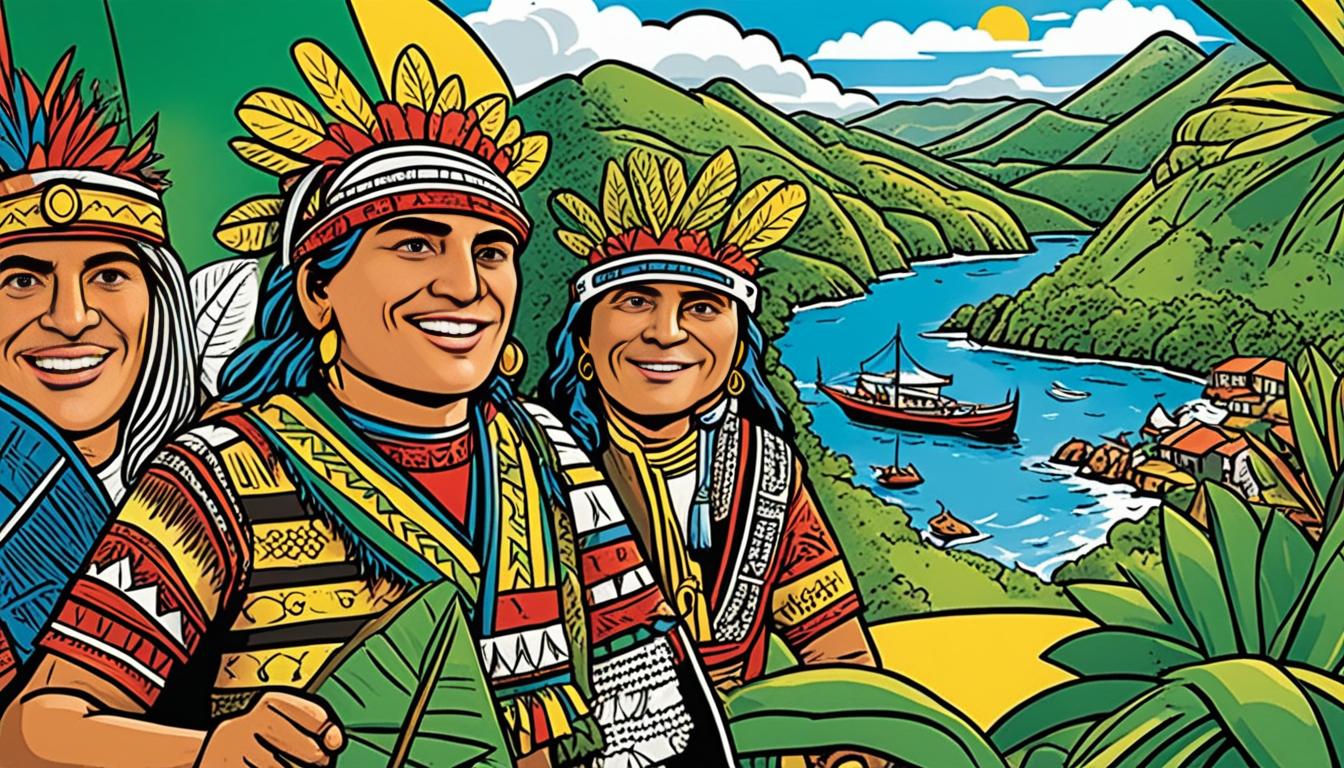Did you know that there are over 300 indigenous languages spoken in Brazil? Among these fascinating tribal languages, one stands out for its historical significance and cultural impact – the Nhengatu language. Also known as Modern Tupi or Amazonic Tupi, Nhengatu is a prominent member of the Tupian language family and plays a crucial role in preserving Brazilian culture and indigenous identity.
With its roots deeply embedded in Brazilian history, the Nhengatu language has stood the test of time, surviving centuries of colonization and language suppression. Today, it continues to be spoken by communities in the Rio Negro region, as well as in parts of Colombia and Venezuela. Its endurance is a testament to the resilience of indigenous cultures and the importance of language preservation.
In this article, we will explore the history, current use, and revitalization efforts surrounding the Nhengatu language. Join us as we dive into the vibrant world of Nhengatu and discover its significance in Brazilian culture.
History of the Nheengatu Language
The Nheengatu language has a fascinating history that dates back to the 18th century. It originated as a natural evolution of the ancient Amazonian Tupinambá language, which was spoken by indigenous Tupinambá communities in the Amazon region.
During this time, Portuguese settlers arrived in the Amazon and came into contact with the indigenous Tupinambá speakers. As a result, a lingua franca known as Nheengatu emerged as a means of communication between the settlers and the local tribes.
However, with the colonization of the Amazon, the Portuguese government aimed to impose the Portuguese language and suppress Nheengatu. The language faced bans and persecution, as the government saw it as a threat to their control over the region.
Despite the efforts to suppress Nheengatu, it managed to persevere and adapt. The decline of the Tupinambá population led to the adoption of Nheengatu among both indigenous and non-indigenous populations, allowing the language to continue thriving to this day.
“The Nheengatu language has withstood colonization and assimilation, serving as a testament to the resilience of indigenous cultures.”
Today, Nheengatu remains an important part of Brazilian linguistic heritage and serves as a symbol of indigenous identity. It is recognized as one of the official languages in certain regions, helping to preserve the cultural diversity and heritage of Brazil.
Current Use and Revitalization Efforts
As of the latest Ethnologue data, approximately 19,000 speakers worldwide continue to embrace the richness of the Nhengatu Language. While mainly spoken in the Rio Negro region of Brazil, its influence extends to certain parts of Colombia and Venezuela as well. In the municipality of São Gabriel da Cachoeira, Nhengatu takes center stage as the primary language spoken by the majority of the population, showcasing its significance in the local culture and heritage.
To ensure the preservation of this indigenous language and promote linguistic diversity, various revitalization efforts are currently underway. These initiatives are particularly focused on engaging and empowering indigenous communities and riverside dwellers, acknowledging the indispensable role of local voices in preserving their linguistic and cultural heritage. Through education, cultural programs, and community-driven projects, the revitalization efforts aim to strengthen the Nhengatu language and its usage among the younger generations.
“Language is the soul of a culture, and preserving the Nhengatu language is essential for the survival and continuity of our ancestral traditions.”
– Ana Silva, Indigenous Community Leader
Furthermore, technology has played a significant role in revitalizing the Nhengatu language. Innovative projects are underway to translate modern technology terms into Nhengatu, bridging the gap between traditional and contemporary language usage. By adapting the language to the digital age, these initiatives aim to ensure that Nhengatu remains relevant and accessible to speakers of all ages.
Revitalization efforts for the Nhengatu language reflect the determination to preserve Brazil’s linguistic diversity and indigenous cultural heritage. By nurturing and promoting the use of Nhengatu, indigenous communities and linguists alike demonstrate their commitment to maintaining the vibrancy and resilience of this remarkable indigenous language.

| Benefits of Language Revitalization Efforts: |
|---|
| Preservation of linguistic diversity |
| Empowerment of indigenous communities |
| Strengthened cultural identity |
| Enhanced intergenerational connection and knowledge transfer |
| Preservation of ancestral traditions |
The Significance of Nheengatu in Brazilian Culture
The Nheengatu language holds immense significance in Brazilian culture and history. Not only does it represent a rich linguistic heritage, but it also serves as a symbol of indigenous identity.
As one of the indigenous languages of Brazil, Nheengatu plays a crucial role in the cultural preservation of indigenous communities. By preserving and revitalizing this language, Brazil helps maintain its linguistic diversity and ensures the survival of indigenous cultures.
Nheengatu provides a way for indigenous communities to connect with their heritage and pass it on to future generations. Through language, traditions, stories, and cultural practices can be preserved, fostering a sense of pride and belonging among indigenous people.
“Language is the expression of a people’s history, culture, and way of life. The preservation of Nheengatu is essential for the preservation of who we are as indigenous people.”
Furthermore, Nheengatu is celebrated for its historical role in the resistance against colonization and assimilation. It serves as a reminder of the strength and resilience of indigenous communities in the face of historical challenges.
To visually honor the importance of Nheengatu in Brazilian culture, below is an image relevant to this section:
By recognizing and valuing the linguistic heritage embedded in Nheengatu, Brazil embraces and respects its indigenous roots, fostering a society that is inclusive and appreciative of its cultural diversity.
Conclusion
The Nhengatu language is a crucial component of Brazil’s cultural heritage and linguistic diversity. The preservation and revitalization of this language are essential for safeguarding indigenous identity and promoting the preservation of cultural traditions. Throughout various regions of Brazil, Nhengatu is still spoken and celebrated, serving as a powerful reminder of the rich Indigenous history and the resilience of local communities.
Efforts to promote and revitalize the Nhengatu language are crucial to its survival and the recognition of its significance in Brazilian culture. By supporting language preservation initiatives, we can ensure the continuation of linguistic diversity and contribute to the cultural richness of the nation. Nhengatu provides a means for indigenous communities to connect with their roots, fostering a sense of belonging and helping to pass down traditional knowledge to future generations.
As Brazil embraces its multicultural heritage, the importance of the Nhengatu language becomes even more evident. It stands as a testament to the indigenous peoples’ enduring cultural legacy and their resistance against colonization and assimilation. Preserving and revitalizing Nhengatu is not only a matter of linguistic preservation but also an affirmation of the unique and invaluable contributions that indigenous communities bring to Brazilian society.
FAQ
How many people speak the Nhengatu language?
Approximately 20,060 people in Brazil speak the Nhengatu language.
Where is the Nhengatu language spoken?
The Nhengatu language is spoken primarily in the Rio Negro region of Brazil, as well as in parts of Colombia and Venezuela.
What is the origin of the Nhengatu language?
The Nhengatu language emerged as a natural evolution of the ancient Amazonian Tupinambá language in the 18th century. It originated as a lingua franca in the Amazon region.
Is the Nhengatu language being revitalized?
Yes, efforts are being made to revitalize and promote the Nhengatu language among indigenous communities and riverside dwellers.
What is the significance of the Nhengatu language in Brazilian culture?
The Nhengatu language represents a rich linguistic heritage, serves as a symbol of indigenous identity, and has played a role in the resistance against colonization and assimilation.
